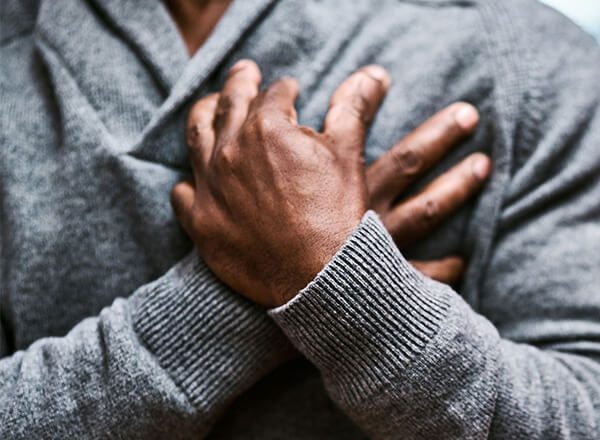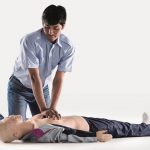The terms "cardiac arrest" and "heart attack" are often used interchangeably, but they're distinct conditions with different causes, symptoms and treatments. Understanding the difference between sudden cardiac arrest vs. heart attack is crucial for recognizing and responding to each appropriately.
What Is a Heart Attack?
A heart attack, medically known as a myocardial infarction, occurs when blood flow to a part of the heart is blocked, usually by a blood clot in a coronary artery. Accordingly, this is considered a circulation problem with the heart. The blockage prevents oxygen-rich blood from reaching a section of the heart muscle, causing that part of the heart to begin to die if the blockage isn't quickly resolved.
Each year in the United States, approximately 605,000 individuals experience their first heart attack, while another 200,000 have recurrent episodes. Among these, an estimated 170,000 incidents are considered silent, presenting minimal or no noticeable symptoms.
-
Heart Attack Symptoms
Heart attack symptoms can vary but often include:
- Intense discomfort or pain in the chest, which may spread to the shoulders, arms, back, neck, jaw or stomach
- Shortness of breath
- Cold sweats
- Nausea or vomiting
- Lightheadedness or sudden dizziness
These symptoms can be sudden and intense. But more commonly, they start slowly and persist over hours, days or even weeks before the heart attack occurs.
The most common symptom for both men and women is chest pain (angina). However, women may be more likely to experience other symptoms that are typically less associated with heart attack, such as nausea/vomiting, back or jaw pain, or shortness of breath.
-
Heart Attack Causes
- Atherosclerosis (plaque buildup in the arteries)
- Blood clots
- Coronary artery spasm
- Recreational drug use
What Is Sudden Cardiac Arrest?
Sudden cardiac arrest occurs when the heart's electrical system malfunctions, causing an irregular heartbeat (arrhythmia). This is considered an electrical problem with the heart. The irregular beat disrupts the heart's pumping action, stopping blood flow to the brain, lungs and other organs. Without immediate treatment, sudden cardiac arrest leads to death within minutes.
Every year in the U.S., 436,000 Americans die from sudden cardiac arrest. Over 350,000 of those occur outside a hospital setting. However, sudden cardiac arrest can be reversed if CPR is promptly administered and a defibrillator is used to deliver a shock to the heart, restoring its normal rhythm.
-
Sudden Cardiac Arrest Symptoms
Sudden cardiac arrest symptoms are immediate and drastic. They can include:
- Sudden collapse
- Unresponsiveness
- No pulse
- No breathing or only gasping
-
Sudden Cardiac Arrest Causes
- Arrhythmias (such as ventricular tachycardia or ventricular fibrillation)
- Heart attack
- Electrical abnormalities
- Scar tissue in the heart from a prior heart attack
- Heart conditions like cardiomyopathy
- Recreational drug use
- Severe blood loss or lack of oxygen
Sudden Cardiac Arrest vs. Heart Attack: The Critical Link
While most heart attacks don't lead to sudden cardiac arrest, it can happen in some cases. Damage from a heart attack can disrupt the heart's electrical system, leading to sudden cardiac arrest. For example, a heart attack could lead to ventricular fibrillation, potentially triggering sudden cardiac arrest.
How to Respond to Sudden Cardiac Arrest
Sudden cardiac arrest can be reversible if treated promptly.
-
1. Call 911
Call 911 immediately, as it helps ensure quick medical response and is a crucial link in the chain of survival.
-
2. Administer High-Quality CPR
Begin chest compressions immediately to maintain blood flow to the brain and other vital organs. Push hard and fast in the center of the chest at a rate of 100 to 120 compressions per minute.
-
3. Use an AED
If available, use an automated external defibrillator (AED) as soon as possible. Follow the device's instructions for use. If two people are available, one should perform CPR while the other calls emergency services and retrieves the AED.
How to Respond to a Heart Attack
If you suspect someone is having a heart attack, assist immediately.
-
1. Call 911
Even if symptoms seem mild, call 911 immediately. Patients who arrive at the hospital via ambulance typically receive faster treatment.
-
2. Stay With the Person
Keep the person seated and calm. Also, loosen any tight clothing to enhance their ability to breathe.
-
3. Monitor Their Status
Be prepared to begin CPR if the person loses consciousness and stops breathing.
Proactive Heart Health Management
The American Heart Association (AHA) emphasizes the importance of a healthy lifestyle to prevent heart disease and improve overall heart health. Here are some proactive steps:
-
Exercise Regularly
Aim for at least 150 minutes of moderate-intensity aerobic activity each week.
-
Maintain a Healthy Diet
Focus on a diet rich in fruits, vegetables, whole grains and lean proteins. Limit saturated fats, trans fats, cholesterol and sodium.
-
Avoid Smoking
Avoid tobacco products and secondhand smoke.
-
Commit to Regular Checkups
Monitor blood pressure, cholesterol levels and diabetes management.
-
Manage Weight
Talk with your healthcare provider about ways to maintain a healthy weight.
-
Prioritize Sleep Health
Get enough quality sleep every night.
-
Address Stress
Practice stress-reducing techniques such as meditation, yoga or deep breathing exercises.
Staying Prepared and Proactive
Understanding the differences between sudden cardiac arrest and heart attack and knowing how to respond to each is vital. Proper intervention can save lives, so recognize the symptoms and practice CPR regularly to keep your lifesaving skills sharp.








